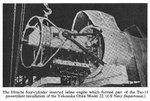mikewint
Captain
I have been able to locate a very few MOTORJETS which says it all in my opinion. The Caproni Campini N.1, which has already been mentioned and the A.I. Mikoyan-M.I. Gurevich I-250(N). The MiG was a Soviet jet aircraft that was the only motorjet ever used by a military. It flew from 1946 to 1950 and was considered a hybrid, as it also had a nose propeller.
I have also been able to determine that late in World War II, the Japanese also experimented with the concept. They developed the Tsu-11 motorjet that was used in the Japanese Ohka kamikaze plane. It was reasoned that use of the Tsu-11 would overcome a major liability of the plane. It had to get very close to enemy aircraft in order to strike and was frequently shot down before it could carry out its mission, a problem the Japanese hoped the Tsu-11 would correct. An example of this is in the Smithsonian National Air and Space Museum in Washington, DC.
In 1942, Americans investigated motorjets in the Naca Jeep project, but never completed research because of interest in turbojets. The German company BMW experimented with motorjets and turbojets in the early 1940s. In the late 1940s, interest in motorjets had declined because turbojets tend to be more fuel-efficient than motorjets which would seem obvious to me. As shortround has already stated, you have to fuel the piston engine AND fuel the jet. So back to my first post REDUNDANT.
Now what we really need is an airplane that flies by flapping its wings an ORNDITHOPTER!
I have also been able to determine that late in World War II, the Japanese also experimented with the concept. They developed the Tsu-11 motorjet that was used in the Japanese Ohka kamikaze plane. It was reasoned that use of the Tsu-11 would overcome a major liability of the plane. It had to get very close to enemy aircraft in order to strike and was frequently shot down before it could carry out its mission, a problem the Japanese hoped the Tsu-11 would correct. An example of this is in the Smithsonian National Air and Space Museum in Washington, DC.
In 1942, Americans investigated motorjets in the Naca Jeep project, but never completed research because of interest in turbojets. The German company BMW experimented with motorjets and turbojets in the early 1940s. In the late 1940s, interest in motorjets had declined because turbojets tend to be more fuel-efficient than motorjets which would seem obvious to me. As shortround has already stated, you have to fuel the piston engine AND fuel the jet. So back to my first post REDUNDANT.
Now what we really need is an airplane that flies by flapping its wings an ORNDITHOPTER!

